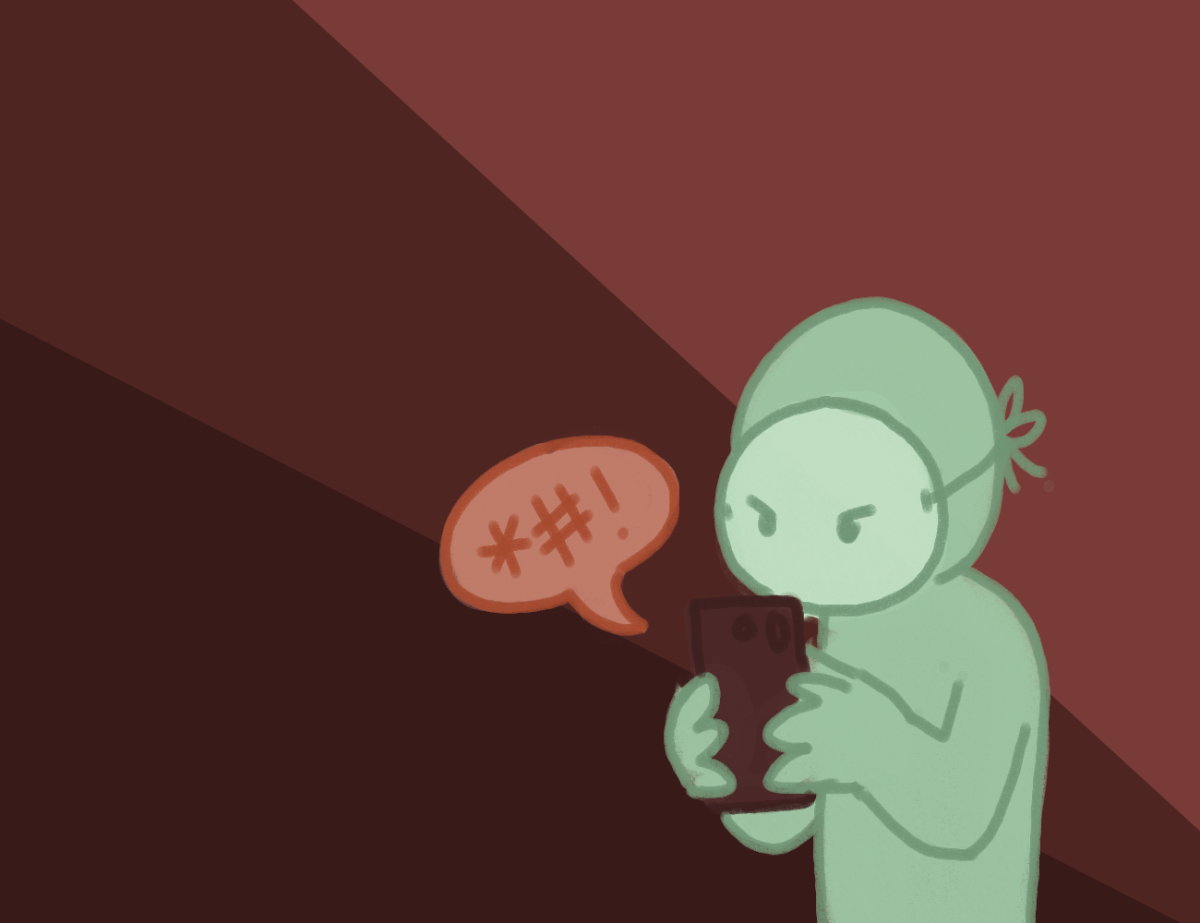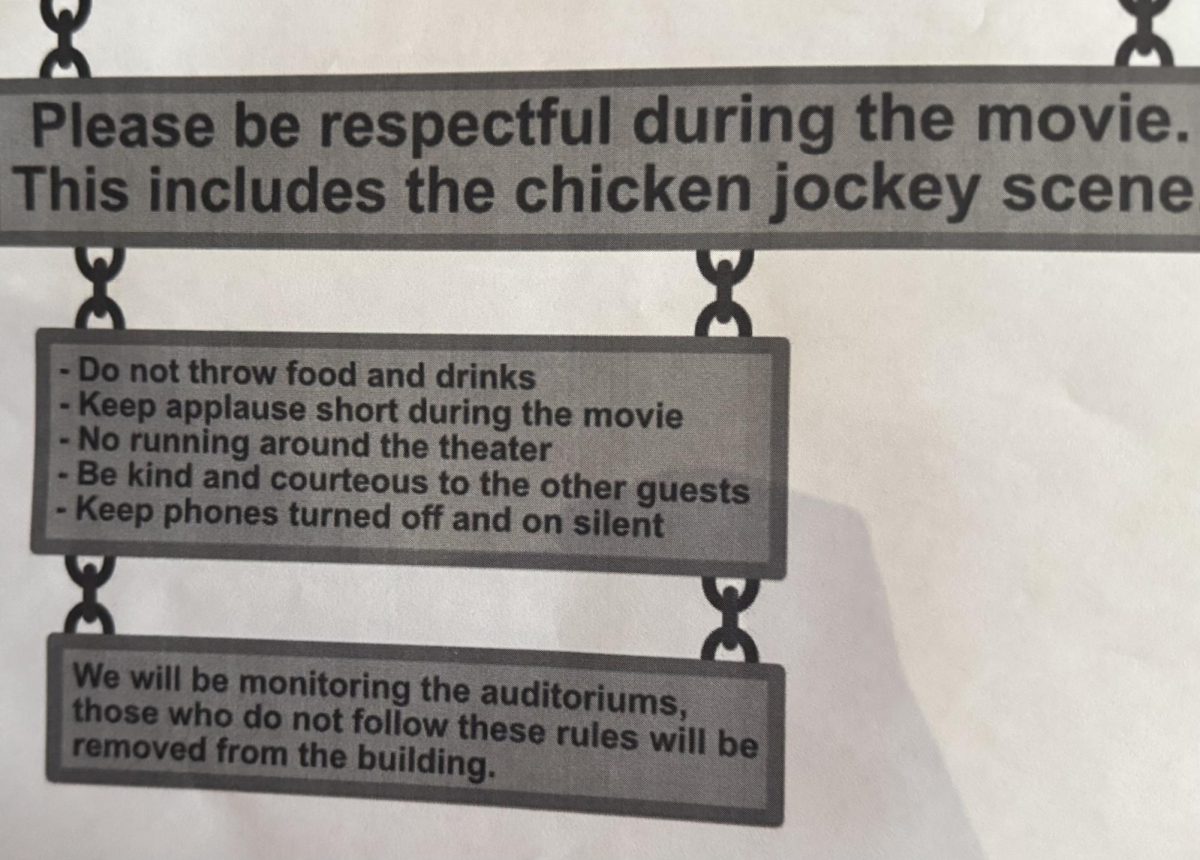The purpose of this essay is to extend the American Studies Department as a safe space.
In 2004, a year after the American Studies Department launched, we purchased the rights to use the image of Faith Ringgold’s oil painting, “The Flag is Bleeding.” Ringgold uses her art to voice her opinions on racism and gender inequality. In 1967, she created a series of paintings, The American People, focused on racial conflict and discrimination. “The Flag is Bleeding,” which is number 18 in the series, depicts an African American man standing next to a white couple. Although the three seem united, the African American man’s wound indicates otherwise.
I love this work of art because the significance is not solely about who is represented in the flag. I often ask students, “Who do you think is missing, and what do you think Ringgold is trying to say about America?”
Many Americans are missing, but for the purpose of this essay, I will focus on the absence of the Black woman. I think that Ringgold is trying to say that Black women are often invisible in the political narrative of America, but we are integral to its very fabric.
In the wee hours of the morning on Wednesday, Nov. 9, we found out that the President-Elect of the United States of America is Donald J. Trump. Although Black women are rarely asked to comment on electoral politics, as a demographic we supported him less than any other group at a mere four percent. The inverse of this equation is that Black women voted for Secretary of State Hillary Clinton at a whopping 94 percent. Notice I said, “voted for.” I didn’t say that we were #WithHer because many of us weren’t.
In my first book, Black Feminist Politics from Kennedy to Clinton, I noted that Vijay Prashad writes that once Bill Clinton was in office, “The braying of the right was so abhorrent and hypocritical that Bill Clinton gained some measure of forgiveness from those who were otherwise livid with him. It was in this context that Toni Morrison said that he was being treated like a Black man: given no quarter, shown no mercy, but treated as guilty as charged without any consideration or process.” Prashad explains how things changed between 1998 and 2008, when Hillary Clinton first ran for president.
“But now, finally Bill Clinton has given us some honesty. He has opened his heart during this primary season, joining Hilary Clinton in pandering to the Old South, the hard core racist bloc that was never reconciled to Civil Rights, that continues to blame Blacks for the vivisections of their economic fortunes. It is this bloc that handed Hillary Clinton the primaries of Pennsylvania, Indiana, West Virginia, and Kentucky. After her loss in the South Carolina primary, where the Democratic electorate is substantially Black, Hilary Clinton’s husband, Bill, told the press, “Jesse Jackson won South Carolina in 1984 and 1988. Jackson ran a good campaign and Obama ran a good campaign here.””
It was after these remarks were made that I predicted that Toni Morrison would take back Bill Clinton’s invitation into the Black family, and indeed she did. Some say that it’s unfair to entangle Hillary with the actions of her husband, but elite white feminism teaches us that marrying a president is the best way for a woman to become a presidential candidate.
Hillary’s pandering to the Old South in 2008 could have been forgiven once the Obamas campaigned for her, but she treated the women from #BlackLivesMatter with dismissive condescension in 2016. In a July 28, 2016 interview with MPRLocal, I actually praised Hillary Clinton for inviting the “Mothers of the Movement” to speak at the Democratic National Convention.
“Black Lives Matter has many issues in their platform, but one of these things we see a lot are these issues of police brutality, so that doesn’t impact most Minnesotans. So, if it doesn’t impact you and you don’t see it, you’re not going to be called to action unless it’s brought to your attention. While the protests have helped build support for practical policies like requiring police officers to wear body cameras, they’ve also helped the general public better understand issues of concern to African-Americans,” I said.
I point to the “Mothers of the Movement” speech at the Democratic National Convention this week, which included nine mothers whose children were killed by police officers or gun violence. “That’s a movement from margin to center where the notion of black lives is directly in the middle of a presidential platform,” I said. “There really is more acceptance in being part of a major party’s presidential campaign and I think people are becoming more aware of what it is like living in a black body in America.”
But Eric Garner’s daughter, Erica, refused to go to the Democratic National Convention because WikiLeaks revealed that it was a ploy to pull on our heartstrings. Despite this, Black women — when they had no real cultural or social obligation to do so — reluctantly got into Beyoncé formation with the Pantsuit Nation. Wednesday’s exit polls revealed that despite Black women’s loyalty, White women weren’t with Hillary Clinton after all.
Black Lives Matter, (which was founded by three Black women), recently published an official response to the election:
“In the months leading up to this election, we have demanded support from white people in dismantling white supremacy—a farce that persuaded some to believe we were living in a post-racial America while simultaneously rolling back the rights of black people and other people of color. White supremacy fortified the decision to disregard racism and sexism as serious variables in the outcome of this election.
Even if everyone didn’t agree politically, at the very least, we deserved to have our collective humanity affirmed. We feel more than disappointed or angry—we feel betrayed.”
L.V. Anderson (who is White) agrees that White women decided that defending their position of power as white people was more important than defending their reproductive rights, their sexual autonomy, their access to health care, family leave and child care. White women bought into Trump’s lies about immigrant rapists and decided they’d rather have the respect of their angry white fathers, brothers and husbands than the respect of literally everyone else in the world.
This is important to the intellectual project of American Studies, which centralizes the question of gender. Anderson writes, “The results of the election indicate that most white women don’t consider themselves part of the coalition of non-white, non-straight, non-male voters who were supposed to carry Clinton to a comfortable victory. Most white women still identify more with white men than they do with Black women, Latina women, Muslim women, transwomen, and every other woman who will have good reason to fear for her physical safety under a Trump regime. And while it’s nonwhite and queer women who have the most to lose under Trump, white women will have to live with the consequences of their own actions in a country without a right to abortion, without access to health insurance, without an adequate family leave policy, and with a head of state who values them only insofar as he wants to fuck them.”
Education was also a great divide, for women as well as for men. The President-Elect won 62 percent of White women without college degrees; Secretary of State Clinton, 34 percent. “Class shapes gender identity,” says Nancy Isenberg, the author of White Trash, which examined how elites have derided rural, working-class Americans from the Colonial era to this day. “I think a lot of people who support Trump think of themselves as being disinherited. They resent the fact that everything they believe in is mocked by the media elite, and Hollywood. That resentment is shared by men and women.”
Liza Featherstone notes that the campaign endlessly touted endorsements from the ranks of the celebrity one-percenters, especially women. In the end, Clinton enjoyed a gender advantage only among the college-educated. Among white women without college degrees, Clinton lost to Trump by 28 points. Featherstone sarcastically comments, “It was almost as if waitresses in Ohio didn’t care that Anna Wintour was #WithHer.” All the talk about angry White men glossed over the fact that they were married to angry White women. This is also why class analysis is critical to the discipline of American Studies. Salamishah Tillet, an Associate Professor of English and Africana studies at the University of Pennsylvania states, “It’s not like Black people or Latino people aren’t sexist and patriarchal. But when we thought about ourselves and collective best interest, we voted for Clinton.”
It is worth noting that 80 percent of the Black men in America who can vote voted for Hillary Clinton. I’d like to add that if Black men couldn’t vote, one might ask how that came to be. (Take Professor Karin Aguilar-San Juan’s Critical Prison Studies course). On any given day in Karin’s class you could read an essay by Nell Painter that will ask you to answer difficult questions like: who defines American whiteness right now? How will white people who didn’t support Mr. Trump in 2016 construe their identity as white people when Trumpists, including white nationalists, Nazis, Klansmen and Steve Bannon, have posted the markers?
If this election has left you feeling vulnerable, I would like to invite you spend time in our department. At our founding in 2003, we described ourselves as “the academic site for the study of race and ethnicity” on Macalester’s campus. More than a decade later, we remain the key site where Macalester students gain exposure to and become versed in critical scholarship on and central debates regarding race and ethnicity. Saying this is not to diminish the other courses or co-curricular programs across campus that contribute to this scholarship. We recognize and support the people and activities whose efforts to build “diversity” and “multiculturalism” are parallel to and supportive of ours. By providing up-to-date and critical scholarship focused primarily on the racialized dimensions of U.S. history and contemporary social life, we offer an indispensable set of research and analytical tools that we believe enhances the Macalester community and student experience as a whole.
As a department we know that you can’t “lean in” to a Democracy that was built on a bridge called your back. Rather, our emphasis is on race as a central dimension of U.S. social, political, cultural and economic life. This reflects an understanding that the prevailing concepts of citizenship, community, freedom and individuality in the United States contain within them deep fissures, erasures and conflicts that depend upon particular constructions of race and racial difference. To move “past race” at this historical moment would be to ignore these conflicts and, in effect, to defuse ongoing struggles for social justice. In stressing the continuing significance of race, we take our cues from the rich and generative scholarship in African American Studies, Asian American Studies, Chicano/Latino Studies, Native American and Indigenous Studies, Women’s and Gender Studies, Queer Studies, critical race theory, cultural studies, and transnational, postcolonial and diaspora studies.
Black Lives Matter insists that we need and deserve an elaborate strategy to eradicate both white supremacy and implicit bias towards it. We must reckon with the anti-Blackness of America’s history that led to this political moment . The American Studies Department has recognized this since our department’s founding and our Nation’s founding, that the American flag has bled, and continues to do so.
Macalester students, we offer a safe space.







warehouses in aurora co • Sep 11, 2019 at 7:53 am
A big thank you for your blog. Keep writing.
roadrunner email login page • Sep 9, 2019 at 7:08 am
Thanks-a-mundo for the blog article.Much thanks again. Cool.
children's party soft play hire • Sep 8, 2019 at 5:15 pm
wow, awesome blog post.Thanks Again. Really Cool.
JUY-990 • Sep 8, 2019 at 10:06 am
Looking forward to reading more. Great article post. Really Great.
liteblue login • Sep 7, 2019 at 3:46 pm
Appreciate you sharing, great post.
Stephanie Underwood • Sep 7, 2019 at 2:17 am
Hello Jackson, if you are a new net user then you must pay a visit everyday this web page and read the updated posts at at this place.
Maths Tutor • Sep 6, 2019 at 1:26 pm
I value the article. Fantastic.
big and tall recliner • Sep 5, 2019 at 10:06 pm
Major thanks for the blog.Really looking forward to read more. Awesome.
kegel balls • Sep 5, 2019 at 6:47 am
A round of applause for your article post.Thanks Again. Really Great.
stainless steel penis ring • Sep 4, 2019 at 6:01 pm
Thanks a lot for the blog article. Fantastic.
content copywriter • Sep 4, 2019 at 6:43 am
Really appreciate you sharing this blog article.Thanks Again. Much obliged.
adam and eve coupon codes • Sep 2, 2019 at 6:35 am
wow, awesome blog article.Much thanks again. Really Cool.
best hollow strapon • Sep 1, 2019 at 8:39 pm
Wow, great blog.Really thank you! Fantastic.
wall mounted dildo • Sep 1, 2019 at 6:29 am
Muchos Gracias for your post.Really looking forward to read more. Want more.
MXGS 1124 • Aug 31, 2019 at 9:39 pm
A round of applause for your article post. Keep writing.
TBF Financial reviews • Aug 30, 2019 at 9:19 pm
This is one awesome article.Thanks Again. Really Great.
Denver permanent brows • Aug 30, 2019 at 2:51 pm
Thanks for sharing, this is a fantastic article post.Really looking forward to read more. Want more.
jobs in nigeria 2019 • Aug 30, 2019 at 7:06 am
I really like and appreciate your blog.Thanks Again. Really Great.
bouncy castles for kids • Aug 29, 2019 at 2:25 pm
Major thanks for the blog. Awesome.
Top business magazines online • Aug 29, 2019 at 10:46 am
Hello there, just became aware of your blog through Google, and found that it is truly informative. I am going to watch out for brussels. I will appreciate if you continue this in future. Lots of people will be benefited from your writing. Cheers!
childrens bouncy castles hammersmith • Aug 29, 2019 at 6:31 am
I appreciate you sharing this blog article.Really thank you! Much obliged.
bouncy castle with slide hire Bexley • Aug 28, 2019 at 11:13 am
Really appreciate you sharing this blog post.Much thanks again. Really Cool.
แทงบอลออนไลน์ฝากขั้นต่ํา100 • Aug 27, 2019 at 10:17 pm
I think this is a real great post.Thanks Again.
free shipping • Aug 26, 2019 at 5:17 pm
Hey, thanks for the post.Really looking forward to read more. Great.
hotmail login • Aug 26, 2019 at 7:34 am
I value the blog article.Really looking forward to read more. Really Great.
แทงบอลวันนี้ • Aug 25, 2019 at 7:27 pm
Enjoyed every bit of your post.Really thank you! Want more.
yellow pages Spain • Aug 25, 2019 at 7:36 am
Hey, thanks for the blog post. Great.
HND-726 • Aug 24, 2019 at 4:42 pm
Major thanks for the blog article.Thanks Again. Really Great.
Badosa • Aug 22, 2019 at 9:53 am
Makes sense to me.
walmart onewire • Aug 21, 2019 at 8:38 pm
Hey, thanks for the blog.Much thanks again. Really Great.
Boston Car Service • Aug 21, 2019 at 3:15 am
Great article post.Thanks Again. Keep writing.
large bouncy castle • Aug 20, 2019 at 6:24 am
Major thankies for the blog article.Really thank you! Much obliged.
JUNY-012 • Aug 19, 2019 at 11:02 pm
I really liked your post.
NIW attorney • Aug 19, 2019 at 5:05 am
Thanks a lot for the article.Really thank you! Want more.
voyance telephone • Aug 18, 2019 at 9:11 pm
Thanks-a-mundo for the article post.Thanks Again. Cool.
CMS blogg • Aug 17, 2019 at 8:16 pm
Muchos Gracias for your article post.Thanks Again. Much obliged.
sound system rental • Aug 17, 2019 at 8:15 am
I think this is a real great article.Much thanks again. Want more.
appnana hack without human verification • Aug 16, 2019 at 12:28 pm
Deference to op , some superb selective information .
bouncy castle service in hammersmith area • Aug 16, 2019 at 11:36 am
This is one awesome blog post.Really thank you! Cool.
paragon ntfs 15 crack • Aug 16, 2019 at 8:41 am
Enjoyed reading through this, very good stuff, thankyou .
1 • Aug 15, 2019 at 12:42 pm
Great article.Much thanks again. Want more.
feebhax.px • Aug 15, 2019 at 7:23 am
Just wanna input on few general things, The website layout is perfect, the articles is very superb : D.
textpad 8 license key • Aug 15, 2019 at 7:06 am
This does interest me
feebahx • Aug 14, 2019 at 3:36 pm
I like this article, useful stuff on here : D.
how to get unlimited money in bloxburg • Aug 14, 2019 at 7:11 am
You got yourself a new rader.
guilty hell hack tool • Aug 13, 2019 at 6:39 pm
Deference to op , some superb selective information .
pz squire roblox • Aug 13, 2019 at 12:25 pm
Deference to op , some superb selective information .
buy tramadol online • Aug 13, 2019 at 5:44 am
Looking forward to reading more. Great article post.Thanks Again. Really Great.
Pat • Aug 12, 2019 at 6:20 pm
Thanks I needed this
power simulator codes roblox • Aug 11, 2019 at 9:21 pm
I am glad to be one of the visitors on this great website (:, appreciate it for posting .
off-grid solar power • Aug 10, 2019 at 8:44 am
Thanks again for the blog post.Really looking forward to read more. Much obliged.
nonsense diamond download • Aug 10, 2019 at 6:44 am
I like this website its a master peace ! Glad I found this on google .
answer first • Aug 10, 2019 at 6:20 am
I simply must tell you that you have an excellent and unique article that I must say enjoyed reading.
xojo 2018 crack • Aug 9, 2019 at 1:23 pm
Great stuff to Read, glad that bing took me here, Keep Up awsome job
maca peruana tribulus terrestris • Aug 9, 2019 at 1:14 pm
Great post.
SSNI-561 • Aug 9, 2019 at 5:07 am
Very good blog post.Really looking forward to read more. Want more.
메이저토토 • Aug 8, 2019 at 5:20 am
I really liked your blog article. Awesome.
roblox mod menu • Aug 7, 2019 at 2:53 pm
You got yourself a new rader.
https://www.youtube.com/ • Aug 7, 2019 at 2:17 pm
A big thank you for your article.Thanks Again. Really Cool.
try these out • Aug 7, 2019 at 5:02 am
Im grateful for the article. Much obliged.
Ormekur kat tyskland • Aug 6, 2019 at 4:55 am
Major thanks for the article post. Want more.
queens banquet hall for weddings • Aug 5, 2019 at 5:34 pm
This is one awesome blog.Thanks Again. Really Cool.
homemade vibrator • Aug 5, 2019 at 4:57 am
Wow, great blog.Thanks Again. Much obliged.
Adam Eve coupon couponokay • Aug 4, 2019 at 7:43 pm
Very informative blog post.
male sex toys • Aug 4, 2019 at 7:01 am
I appreciate you sharing this blog.Really thank you!
swedish • Aug 3, 2019 at 6:31 pm
Major thanks for the article.Really looking forward to read more. Much obliged.
Buy Tramadol Online USA • Aug 3, 2019 at 5:54 am
I loved your article.Thanks Again.
Commerce Tutor • Aug 2, 2019 at 5:46 pm
Thanks for the blog.Really thank you! Really Cool.
http://ebusinesspages.com/Muscle-Labs-Sports-Supplements_dwn20.co • Aug 2, 2019 at 11:11 am
I really like and appreciate your article post.Thanks Again. Fantastic.
xbox one mods free download • Jul 30, 2019 at 1:29 pm
Enjoyed reading through this, very good stuff, thankyou .
removals blackpool • Jul 29, 2019 at 9:32 pm
Im thankful for the post.Really thank you! Will read on…
check it out • Jul 29, 2019 at 9:16 pm
I cannot thank you enough for the blog.Thanks Again. Fantastic.
best dildo review • Jul 29, 2019 at 10:54 am
Im thankful for the article post.Really looking forward to read more. Keep writing.
big dildo • Jul 29, 2019 at 4:57 am
Muchos Gracias for your post. Awesome.
https://www.youtube.com/watch?v=zi5IEYdRREw&t=45s • Jul 28, 2019 at 10:18 pm
It is racist to deny Whites & Arabs are a mix of blond haired blue eyed white skinned Nordics and the Indian race, do you agree?
Hunter hundeseng • Jul 28, 2019 at 8:01 am
Muchos Gracias for your blog post.Really thank you! Really Great.
realistic vibrating dildo • Jul 27, 2019 at 9:38 pm
Really appreciate you sharing this blog post.Much thanks again. Will read on…
vagina toy • Jul 27, 2019 at 11:07 am
I really liked your blog. Great.
JUY-945 • Jul 26, 2019 at 9:53 am
A round of applause for your blog post. Really Cool.
skisploit • Jul 26, 2019 at 7:55 am
Hello, i really think i will be back to your website
skisploit • Jul 25, 2019 at 6:49 am
Deference to op , some superb selective information .
Change Bigpond Email Passwor • Jul 24, 2019 at 7:38 pm
Looking forward to reading more. Great article post.Much thanks again. Will read on…
http://moviesporno.net/ • Jul 24, 2019 at 1:34 pm
Hey, thanks for the blog.Much thanks again. Awesome.
monster hunter world free key • Jul 24, 2019 at 5:03 am
I was looking at some of your articles on this site and I believe this internet site is really instructive! Keep on posting .
Dubai • Jul 23, 2019 at 5:02 pm
Enjoyed every bit of your post.Thanks Again. Will read on…
acid swapper download • Jul 23, 2019 at 4:39 am
I was looking at some of your articles on this site and I believe this internet site is really instructive! Keep on posting .
Eliseo Stealey • Jul 22, 2019 at 10:40 pm
Mass parsite http://bit.ly/2W9CVkn
Karate classes in Natomas • Jul 22, 2019 at 4:42 am
Im thankful for the article post.Thanks Again.
eebest8 mmx • Jul 21, 2019 at 8:42 am
fantastic post, very informative. I wonder why the other specialists of this sector don’t notice this. You must continue your writing. I am confident, you’ve a huge readers’ base already!
eebest8 smm
how to hack prodigy • Jul 21, 2019 at 6:45 am
I consider something really special in this site.
https://www.uspslitebluelogin.net/ • Jul 20, 2019 at 1:04 pm
wow, awesome blog.
http //blue.usps.gov/wps/portal/ • Jul 20, 2019 at 6:45 am
Looking forward to reading more. Great post.Much thanks again. Want more.
Short Term Capital • Jul 19, 2019 at 1:55 pm
Enjoyed every bit of your blog.Much thanks again.
roblox fps unlocker • Jul 9, 2019 at 2:00 am
Cheers, great stuff, I like.
spyhunter 5.4.2.101 portable • Jul 8, 2019 at 12:24 am
I like this website its a master peace ! Glad I found this on google .
call of duty black ops 4 license key.txt • Jul 7, 2019 at 12:21 am
I kinda got into this article. I found it to be interesting and loaded with unique points of view.
rekordbox torrent download • Jul 6, 2019 at 1:55 pm
Found this on bing and I’m happy I did. Well written web.
gx tool uc hack app download • Jul 6, 2019 at 2:59 am
bing got me here. Thanks!
synapse x free • Jul 5, 2019 at 10:47 pm
I simply must tell you that you have an excellent and unique site that I really enjoyed reading.
tom clancy's the division hacks • Jul 5, 2019 at 11:23 am
Good Day, glad that i saw on this in google. Thanks!
dego pubg hack • Jul 4, 2019 at 11:09 pm
I like this site because so much useful stuff on here : D.
subbot • Jul 4, 2019 at 10:55 am
Great stuff to check out, glad that duckduck brought me here, Keep Up great job
prison life hack download • Jul 3, 2019 at 11:09 pm
Appreciate it for this howling post, I am glad I observed this internet site on yahoo.
cyberhackid • Jul 3, 2019 at 11:09 am
I have interest in this, thanks.
vn hack • Jul 2, 2019 at 11:13 pm
I was looking at some of your articles on this site and I believe this internet site is really instructive! Keep on posting .
redline v3.0 • Jul 2, 2019 at 5:05 am
I must say, as a lot as I enjoyed reading what you had to say, I couldnt help but lose interest after a while.
free cheats for rust • Jul 1, 2019 at 11:33 pm
I must say, as a lot as I enjoyed reading what you had to say, I couldnt help but lose interest after a while.
cheat fortnite download no wirus • Jul 1, 2019 at 11:40 am
Great writing to see, glad that google led me here, Keep Up cool job
check cashed v3 download • Jul 1, 2019 at 12:54 am
Great, this is what I was browsing for in google
cryptotab script hack free download • Jun 29, 2019 at 6:44 am
You got yourself a new rader.
cryptotab hack script free download 2019 • Jun 29, 2019 at 12:24 am
Found this on yahoo and I’m happy I did. Well written article.
advanced systemcare 11.5 key • Jun 28, 2019 at 5:17 am
I love reading through and I believe this website got some genuinely utilitarian stuff on it! .
synapse x serial key • Jun 27, 2019 at 12:34 pm
Respect to website author , some wonderful entropy.
krunker aimbot • Jun 25, 2019 at 10:18 pm
I dugg some of you post as I thought they were very beneficial invaluable
hunde vitaminer • Jun 25, 2019 at 9:58 pm
I value the blog post.Thanks Again. Cool.
qureka pro apk • Jun 25, 2019 at 11:39 am
Respect to website author , some wonderful entropy.
free online Q & A • Jun 24, 2019 at 8:47 pm
Some truly interesting article on this web site , appreciate it for contribution.
game of dice cheats • Jun 23, 2019 at 8:54 am
I’m impressed, I have to admit. Genuinely rarely should i encounter a weblog that’s both educative and entertaining, and let me tell you, you may have hit the nail about the head. Your idea is outstanding; the problem is an element that insufficient persons are speaking intelligently about. I am delighted we came across this during my look for something with this.
nonsense diamond download • Jun 20, 2019 at 11:26 pm
Me like, will read more. Cheers!
vn hax download • Jun 20, 2019 at 10:13 am
Enjoyed reading through this, very good stuff, thankyou .
proxo key generator • Jun 19, 2019 at 1:17 am
I truly enjoy looking through on this web site , it holds superb content .
ปั้มไลค์ • Jun 17, 2019 at 6:17 pm
Like!! I blog quite often and I genuinely thank you for your information. The article has truly peaked my interest.
krunker aimbot • Jun 16, 2019 at 2:55 pm
Morning, here from baidu, i enjoyng this, I come back again.
vn hax pubg • Jun 3, 2019 at 2:09 am
Just wanna input on few general things, The website layout is perfect, the articles is very superb : D.
hacks counter blox script • Jun 1, 2019 at 10:20 pm
I truly enjoy looking through on this web site , it holds superb content .
mpl pro • Jun 1, 2019 at 10:14 am
I conceive you have mentioned some very interesting details , appreciate it for the post.
fortnite aimbot download • May 31, 2019 at 7:14 am
stays on topic and states valid points. Thank you.
xbox one mods free download • May 31, 2019 at 4:29 am
Deference to op , some superb selective information .
vn hax • May 29, 2019 at 9:55 pm
I like this site because so much useful stuff on here : D.
redline v3.0 • May 29, 2019 at 8:43 am
I like this website its a master peace ! Glad I found this on google .
aimbot free download fortnite • May 29, 2019 at 4:16 am
Thanks for this post. I definitely agree with what you are saying.
ispoofer activation key • May 29, 2019 at 12:17 am
I truly enjoy looking through on this web site , it holds superb content .
expressvpn key • May 28, 2019 at 11:05 am
Ha, here from bing, this is what i was looking for.
strucid hacks • May 28, 2019 at 2:02 am
Respect to website author , some wonderful entropy.
rust hacks • May 27, 2019 at 11:44 am
Your site has proven useful to me.
sims 4 seasons free code • May 26, 2019 at 11:10 pm
Appreciate it for this howling post, I am glad I observed this internet site on yahoo.
resetter epson l1110 • May 26, 2019 at 9:53 am
Yeah bookmaking this wasn’t a risky decision outstanding post! .
smart defrag 6.2 serial key • May 26, 2019 at 7:19 am
Yeah bookmaking this wasn’t a risky decision outstanding post! .
iobit uninstaller 7.5 key • May 26, 2019 at 12:59 am
Thanks for this post. I definitely agree with what you are saying.
cheats for hempire game • May 25, 2019 at 10:12 pm
Just wanna input on few general things, The website layout is perfect, the articles is very superb : D.
ispoofer pogo activate seriale • May 24, 2019 at 9:41 am
I am glad to be one of the visitors on this great website (:, appreciate it for posting .
eternity.cc v9 • May 23, 2019 at 11:19 pm
This is cool!
bitcoin adder v.1.3.00 free download • May 23, 2019 at 1:46 am
I conceive this web site holds some real superb information for everyone : D.
krunker hacks • May 22, 2019 at 10:08 pm
Enjoyed reading through this, very good stuff, thankyou .
nonsense diamond • May 22, 2019 at 9:50 am
I must say, as a lot as I enjoyed reading what you had to say, I couldnt help but lose interest after a while.
free fire hack version unlimited diamond • May 21, 2019 at 7:59 am
Respect to website author , some wonderful entropy.
redline v3.0 • May 20, 2019 at 10:46 pm
stays on topic and states valid points. Thank you.
smutstone • May 20, 2019 at 3:17 am
Some truly cool content on this web site , appreciate it for contribution.
mining simulator codes 2019 • May 18, 2019 at 10:37 pm
I really enjoy examining on this internet site , it has got fine stuff .
forza horizon 4 license key • May 18, 2019 at 6:38 am
I dugg some of you post as I thought they were very beneficial invaluable
badoo superpowers free • May 17, 2019 at 11:46 pm
Cheers, here from yanex, me enjoyng this, will come back again.
redline v3.0 • May 17, 2019 at 10:20 am
Me like, will read more. Cheers!
red dead redemption 2 digital key resale • May 17, 2019 at 7:17 am
I love reading through and I believe this website got some genuinely utilitarian stuff on it! .
fallout 76 hacks • May 17, 2019 at 2:07 am
Thank You for this.
nonsense diamond 1.9 • May 16, 2019 at 10:39 pm
bing took me here. Thanks!
fortnite aimbot download • May 16, 2019 at 8:26 am
I really enjoy examining on this internet site , it has got fine stuff .
krunker hacks • May 16, 2019 at 4:32 am
I’m impressed, I have to admit. Genuinely rarely should i encounter a weblog that’s both educative and entertaining, and let me tell you, you may have hit the nail about the head. Your idea is outstanding; the problem is an element that insufficient persons are speaking intelligently about. I am delighted we came across this during my look for something with this.
warframe aimbot • May 15, 2019 at 7:16 am
Respect to website author , some wonderful entropy.